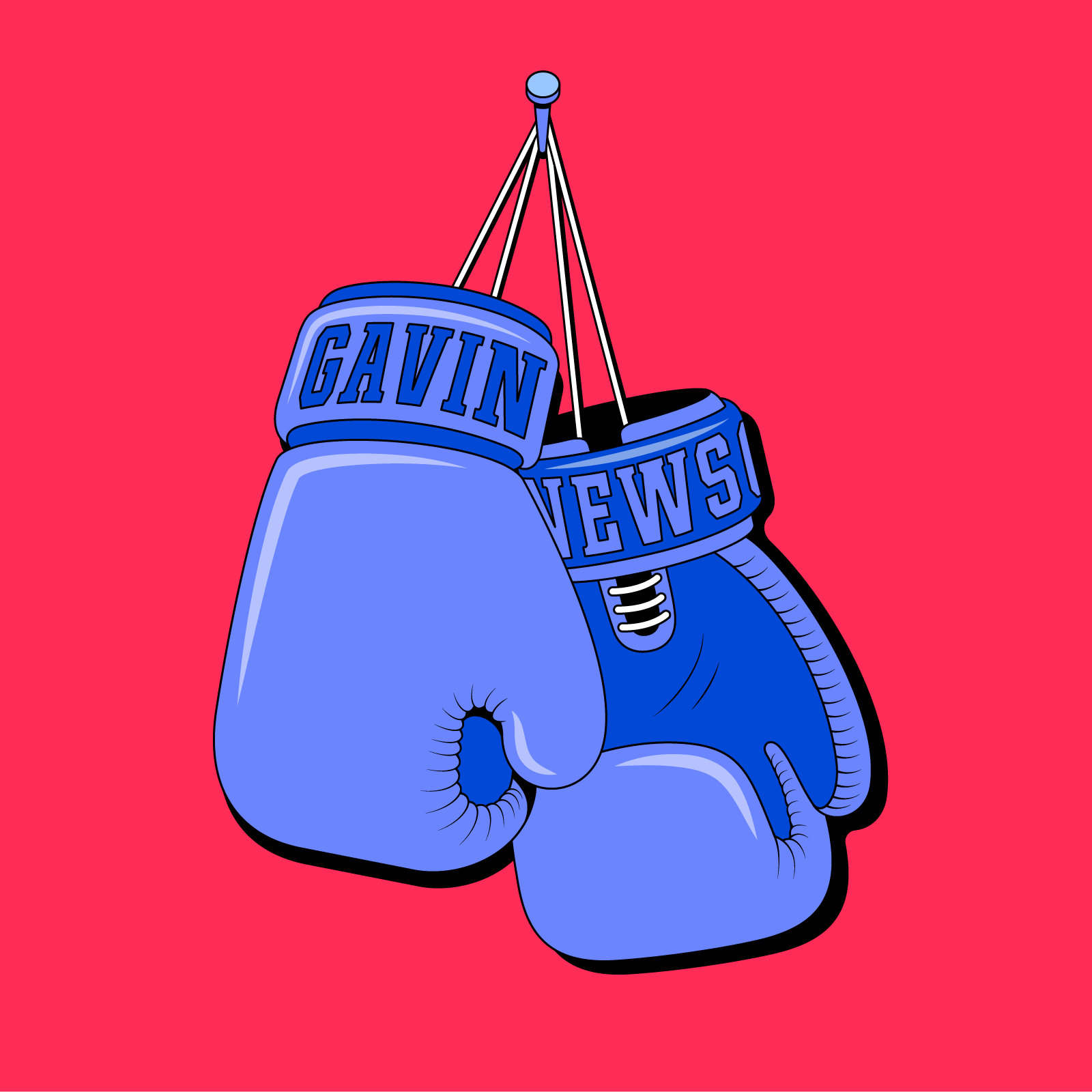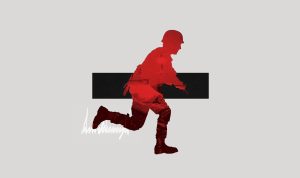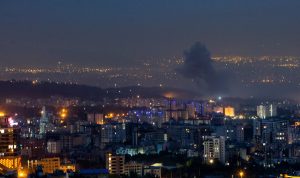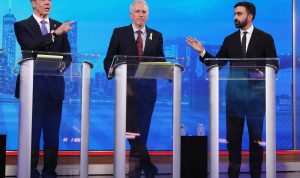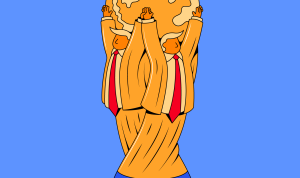For this week’s Fault Lines column, Jon Allsop is filling in for Jay Caspian Kang.
Earlier this year, Gavin Newsom, the governor of California, launched a podcast that promised direct conversations with people he disagrees with. In reality, it featured him sucking up to figures from theMAGAExtended Universe. Inthe début episode,the guest was Charlie Kirk, an influential young right-wing activist and commentator; Newsom suggested that his thirteen-year-old son was so excited to meet Kirk that he wanted to skip school to attend the taping. (Newsom didn’t let him. “C’mon,” Kirk objected. “You cancelled school for like two years!” Newsom seemed to find this funny.) The following week, Steve Bannon came on the show and said that the 2020 election was stolen; Newsom let this slide. Recently, in the wake of the protests against immigration raids in Los Angeles, Kirk and Bannon have returned Newsom’s hospitality by, respectively, calling him “the fakest person I’ve ever met” and comparing him to John C. Calhoun. Newsom, for his part, has pushed back strongly against the Trump Administration’s militarized response to the protests, challenging Tom Homan, President Trump’s border czar, to arrest him (“Come and get me, tough guy”) and tweaking Trump himself in TikTok memes inspired by “Hamilton” andTaylor Swift. With enemies like these, who needs friends?
Jay Caspian Kang pointed outin this column, in March, that Newsom’s podcast always seemed doomed to fail—not to mention “embarrassing”—because his conciliatory approach was out of step with polling that indicated liberals want to see Democrats fight Trump’s Republican Party, not get along with it. Ina different column, Kang similarly took issue with a school of thought, advanced most explicitly by the veteran strategist James Carville, holding that Democrats should “roll over and play dead,” allowing Trump to burn himself out. As Kang put it, this strategy never seemed viable, either, and several recent developments signal that playing dead is, well, dead. Newsom’s newfound combativeness is one example. Another came last week, also in relation to the L.A. protests, when Alex Padilla, the normally mild-mannered California senator, confronted Kristi Noem, the Homeland Security Secretary, at a press conference, and was forced to the floor and handcuffed by federal agents. This week, there were similar scenes in New York City, where agents arrested Brad Lander, the comptroller and a candidate for mayor, while he was accompanying a migrant in immigration court. In between, millions of anti-Trump demonstrators protested across the country under the banner “No Kings.”
It’s possible to see all this as the dormant resistance to Trump finally awakening. But that isn’t really correct. AsI wrote in the first days of the new Administration, Trump’s opponents may not have marshalled anything like the enormous Women’s March of January, 2017, but civil-society groups had started to organize their supporters, and many of Trump’s early moves were quickly challenged in court. Since then, therehavebeen a lot of protests—even more, by one count, than in the equivalent stretch of Trump’s first term—though the media, as Kang noted, hasn’t always covered them to the same extent. Newsom may only just have found his voice, but other leading Democrats—the Illinois governor,J. B. Pritzker, for example—never lost theirs. Earlier this year, I felt sure that this sort of activity would spread and intensify, as it now has, if only because Trump’s political project ultimatelyrequiresresistance—which generates conflict—in order to thrive, and he will keep pushing until inevitably provoking his opponents. Newsom is a case in point. His grovelling may have been of some use to the likes of Kirk and Bannon, but he’s much more useful as a foil, an avatar of a woke élite that’s imperilling America. Being a foil may be useful to Newsom, too. One ally told NBC that if Newsomwereto be arrested for supposedly obstructing Trump’s immigration raids, it would be his “Nelson Mandela moment”—a comparison that has surely not been made before, and hopefully won’t be again.
We are, unfortunately, at the point in this column where I must capitalize the word “Resistance,” and maybe add a hashtag for good measure. As I’ve previouslynoted, with these accoutrements, the word comes to signify something more than merely fighting back, becoming freighted with the cultural signifiers of the liberal opposition to Trump’s first term. (Think “Notorious R.B.G.” tote bags, Jimmy Kimmel proposing that Trump become a ceremonial king in exchange for going away as President, the cast of “Hamilton” confronting then Vice-President Mike Pence.) As Trump returned to office, this #Resistancedidappear to be dead. Now Newsom is posting “Hamilton” memes, and Jimmy Kimmel has shown up at a “No Kings” protest. I do still think we’re in a different moment. (The old Twitter is gone, for starters.) But the basic animating spirit of the #Resistance has clearly survived.
Still, it remains an open question what a new Resistance might look like, how it might cohere or be channelled. In February, Kang posed precisely that question in this column. He toyed with historical precedents—Goldwater Republicanism, the Tea Party—but found them imprecise and largely unhelpful. He described the contours of a “nü-Resistance”—which he characterized as “angry, oppositional, and ideologically chaotic,” and severed from various pillars of the Democratic establishment—but wasn’t yet sure where that energy might go.
Nearly half a year later, we have some new data points. The framework of a Democratic Tea Party remains unhelpful—butsomethingis going on inside (and, now, outside) the Democratic National Committee, which has recently been riven by threats to primary complacent incumbents (and, now, Democrats who support going to war with Iran). These tensions have been whipped up, most notably, by David Hogg, the Parkland shooting survivor turned activist turned short-serving D.N.C. vice-chair. (After other D.N.C. leaders clashed with Hogg, his election was invalidated on procedural grounds, and he ultimately declined to run again for the post.) And Newsom, Padilla, and the “No Kings” protests appear to have harnessed some of the loose energy recently.
But other reported efforts to counter Trump’s appeal—throwing money at influencers in the hope of finding the “next Joe Rogan,” a project to study “the syntax, language and content” that appeal to young men—demonstrate the limits of top-down attempts to cultivate political energy, as well as the persistent staleness of the institutional Democratic brand. At this stage, it seems to me that “young men,” never as homogeneous a voting bloc as imagined by post-election pundits, are vastly more likely to get bored ofMAGAthan to be seduced by the political equivalent of Steve Buscemi with a skateboard asking them, “How do you vote, fellow-kids?” More substantively, the ideological contours of the new Resistance still feel unsettled. Uncompromising opposition to Trump’s most brazen maneuversdoesincreasingly look like a unifying approach. But, even there, consensus is not yet total. Some Democrats have fretted that Trump’s L.A. crackdown is bait to distract them from kitchen-table issues. Gretchen Whitmer—the governor of Michigan and, like Newsom, a leading candidate to be the Democrats’ next standard-bearer—has pursued a strategy of working with the Administration. If Newsom’s podcast supplied the most humiliating audio of the new Trump era, the most humiliating image was surelya photo of Whitmerphysically hiding in the Oval Office as Trump signed orders to investigate a pair of first-term officials who went on to criticize him. This hasn’t seemed to hurt her standing—at least in Michigan—and she has been able to tout some policy victories, most notably obtaining new fighter jets for a local base.
As with Newsom, I suspect that Trump will at some point drive Whitmer past breaking point. (Already, he has suggested that he might pardon the men convicted of trying to kidnap her, in 2020; what happens if he attempts to send the Marines to Detroit?) Then again, the notion that Newsom started his podcast with the pure intention of reaching out toMAGA, only to be met with actions that he couldn’t possibly accept, may underplay his political cunning. It’s not hard to imagine Newsom embarking on the podcast—which, as Kang noted, immediately went down horribly with the Democratic base—knowing full well that he would soon be back in Resistance-leader mode, but seeing it, in the interim, as a useful way to distance himself from progressive totems that he perceives as toxic (for instance, trans athletes competing in girls’ sports, which he disavowed to Kirk), or something to point to and say, “Look, I really did try reasoning with these people!”
And this is assuming that Newsom actuallyhaspivoted away from the podcast-conciliation strategy, which isn’t clear, even if he certainly has movedtowardResistance leadership. As recently as June 4th, he posted another cloyingly folksy conversation, this time with Dr. Phil, who described himself as “the least political person I know” before extolling family values and weighing in on “pro-Hamas” protests on college campuses; two days later, the L.A. raids began. (Dr. Phil was on the scene, having been granted special access, for some reason, to document immigration-enforcement actions.) Last week,Newsomwas interviewed on “The Daily,” the New YorkTimes’ flagship podcast, and without any prompting stressed that he has “no problem meeting with people and talking to people I disagree with,” as “some of your viewers and listeners may know.” Asked about his podcast, he indicated that he still sees it as “incredibly important” to show “a little humility” toward his adversaries, and to listen.
Back in February, Kang concluded that, when it came to the emerging opposition to Trump, “what we are seeing is not a shift in policy preferences but, rather, the dissolution of traditional political logic in this country.” I’m not sure I’d go quite this far. It’s perfectly logical, in light of how Trump is behaving, that the opposition is intensifying; it is also not surprising—or necessarily concerning—that Democrats haven’t yet articulated a coherent new policy platform less than a year on from a priors-shattering defeat. But Newsom and many of his fellow-Democrats do seem to be trying to have it both ways—to prove that you can joke around with Steve Bannonandpost “Hamilton” memes about Trump without disappearing down the gaping chasm between those acts. WhenI last wrote about Trump resistance in this column, it was to argue that it will have to coalesce, if it does at all, within a fragmented media ecosystem; Newsom, perhaps, is trying to game the choose-your-own-adventure quality of this ecosystem by putting out different content that might seep into, and resonate within, very different filter bubbles. I think this is doomed to fail because it (and he) is palpably inauthentic, and authenticity—or, rather, the perception thereof—is king in this media environment. But someone else might manage to do it. If the new Resistance remains hard to define, that’s partly because it’s still early. There’s no inevitability of neat coherence down the line. One thing is for sure: the mass protests will continue. ♦

